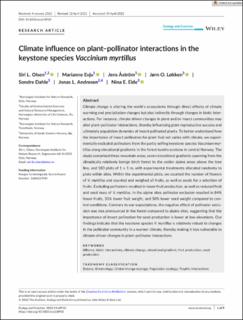| dc.contributor.author | Olsen, Siri Lie | |
| dc.contributor.author | Evju, Marianne | |
| dc.contributor.author | Åström, Jens | |
| dc.contributor.author | Løkken, Jørn Olav | |
| dc.contributor.author | Dahle, Sondre | |
| dc.contributor.author | Andresen, Jonas | |
| dc.contributor.author | Eide, Nina Elisabeth | |
| dc.date.accessioned | 2022-06-09T12:41:00Z | |
| dc.date.available | 2022-06-09T12:41:00Z | |
| dc.date.created | 2022-05-25T08:29:13Z | |
| dc.date.issued | 2022 | |
| dc.identifier.citation | Olsen, S. L., Evju, M., Åström, J., Løkken, J. O., Dahle, S., Andresen, J. L. & Eide, N. E. (2022). Climate influence on plant–pollinator interactions in the keystone species Vaccinium myrtillus. Ecology and Evolution, 12(5), Artikkel e8910. | en_US |
| dc.identifier.issn | 2045-7758 | |
| dc.identifier.uri | https://hdl.handle.net/11250/2998172 | |
| dc.description.abstract | Climate change is altering the world's ecosystems through direct effects of climate warming and precipitation changes but also indirectly through changes in biotic interactions. For instance, climate-driven changes in plant and/or insect communities may alter plant–pollinator interactions, thereby influencing plant reproductive success and ultimately population dynamics of insect-pollinated plants. To better understand how the importance of insect pollination for plant fruit set varies with climate, we experimentally excluded pollinators from the partly selfing keystone species Vaccinium myrtillus along elevational gradients in the forest-tundra ecotone in central Norway. The study comprised three mountain areas, seven elevational gradients spanning from the climatically relatively benign birch forest to the colder alpine areas above the tree line, and 180 plots of 1 × 1 m, with experimental treatments allocated randomly to plots within sites. Within the experimental plots, we counted the number of flowers of V. myrtillus and counted and weighed all fruits, as well as seeds for a selection of fruits. Excluding pollinators resulted in lower fruit production, as well as reduced fruit and seed mass of V. myrtillus. In the alpine sites pollinator exclusion resulted in 84% fewer fruits, 50% lower fruit weight, and 50% lower seed weight compared to control conditions. Contrary to our expectations, the negative effect of pollinator exclusion was less pronounced in the forest compared to alpine sites, suggesting that the importance of insect pollination for seed production is lower at low elevations. Our findings indicate that the keystone species V. myrtillus is relatively robust to changes in the pollinator community in a warmer climate, thereby making it less vulnerable to climate-driven changes in plant–pollinator interactions. | en_US |
| dc.language.iso | eng | en_US |
| dc.rights | Navngivelse 4.0 Internasjonal | * |
| dc.rights.uri | http://creativecommons.org/licenses/by/4.0/deed.no | * |
| dc.title | Climate influence on plant–pollinator interactions in the keystone species Vaccinium myrtillus | en_US |
| dc.type | Journal article | en_US |
| dc.type | Peer reviewed | en_US |
| dc.description.version | publishedVersion | en_US |
| dc.rights.holder | © 2022 The Authors. | en_US |
| dc.subject.nsi | VDP::Zoologiske og botaniske fag: 480 | en_US |
| dc.subject.nsi | VDP::Zoology and botany: 480 | en_US |
| dc.source.volume | 12 | en_US |
| dc.source.journal | Ecology and Evolution | en_US |
| dc.source.issue | 5 | en_US |
| dc.identifier.doi | https://doi.org/10.1002/ece3.8910 | |
| dc.identifier.cristin | 2027164 | |
| dc.relation.project | Norges forskningsråd: 160022 | en_US |
| dc.source.articlenumber | e8910 | en_US |
| cristin.ispublished | true | |
| cristin.fulltext | original | |
| cristin.qualitycode | 1 | |

